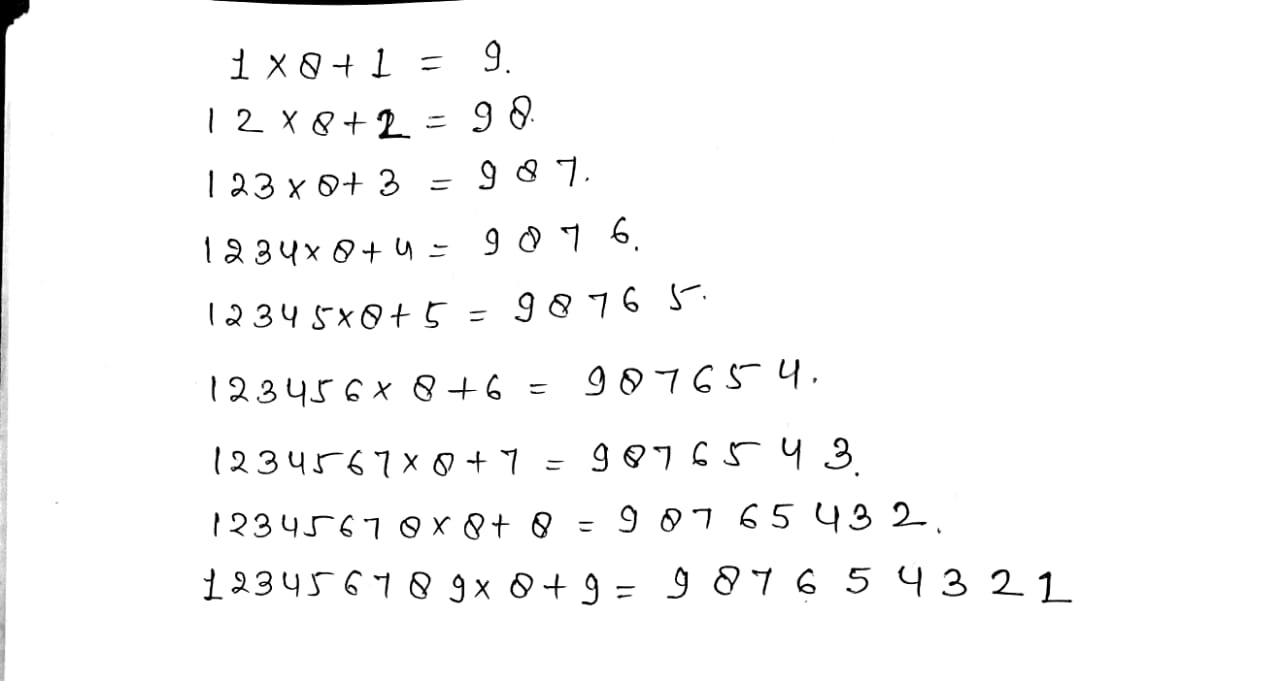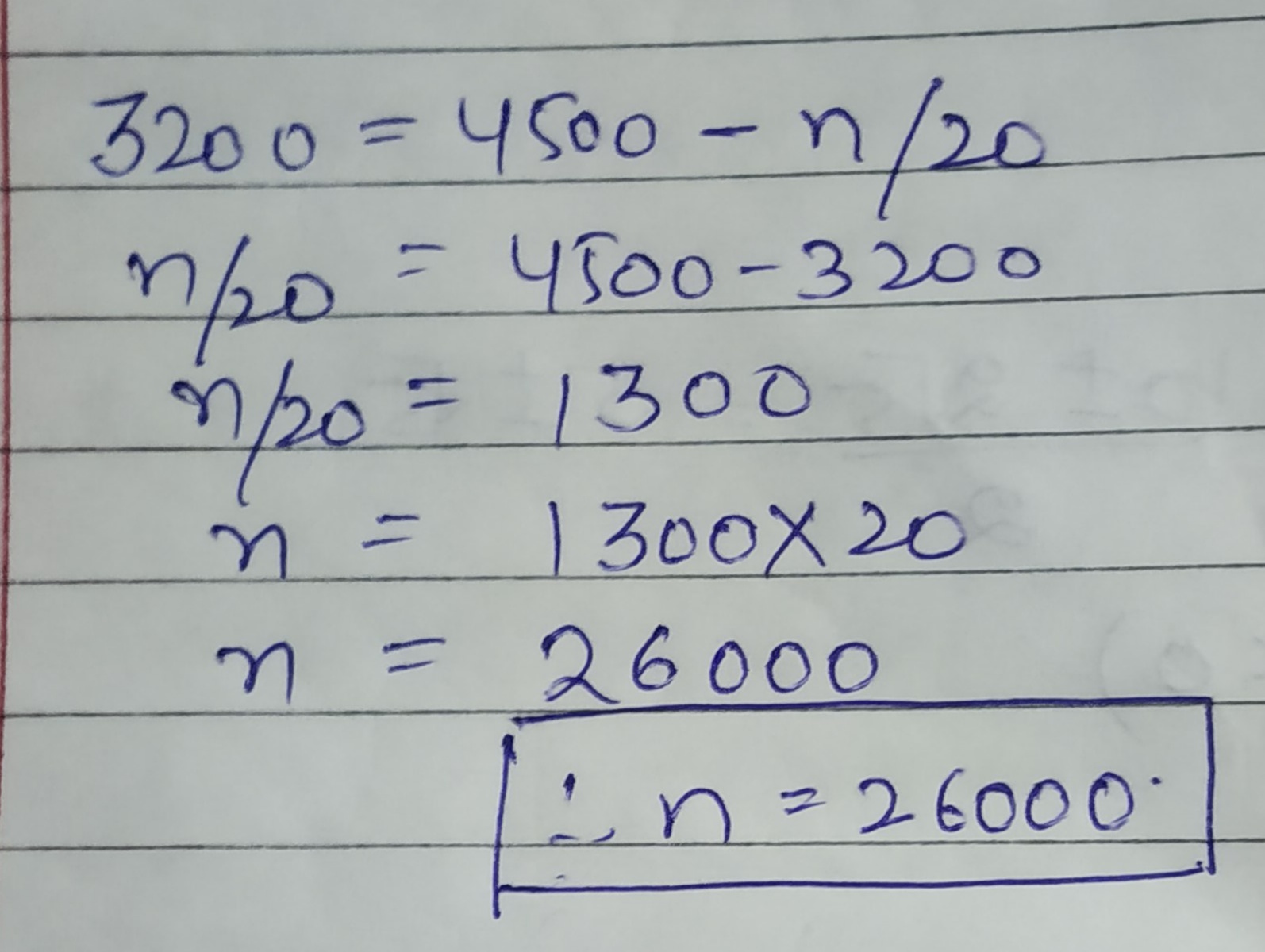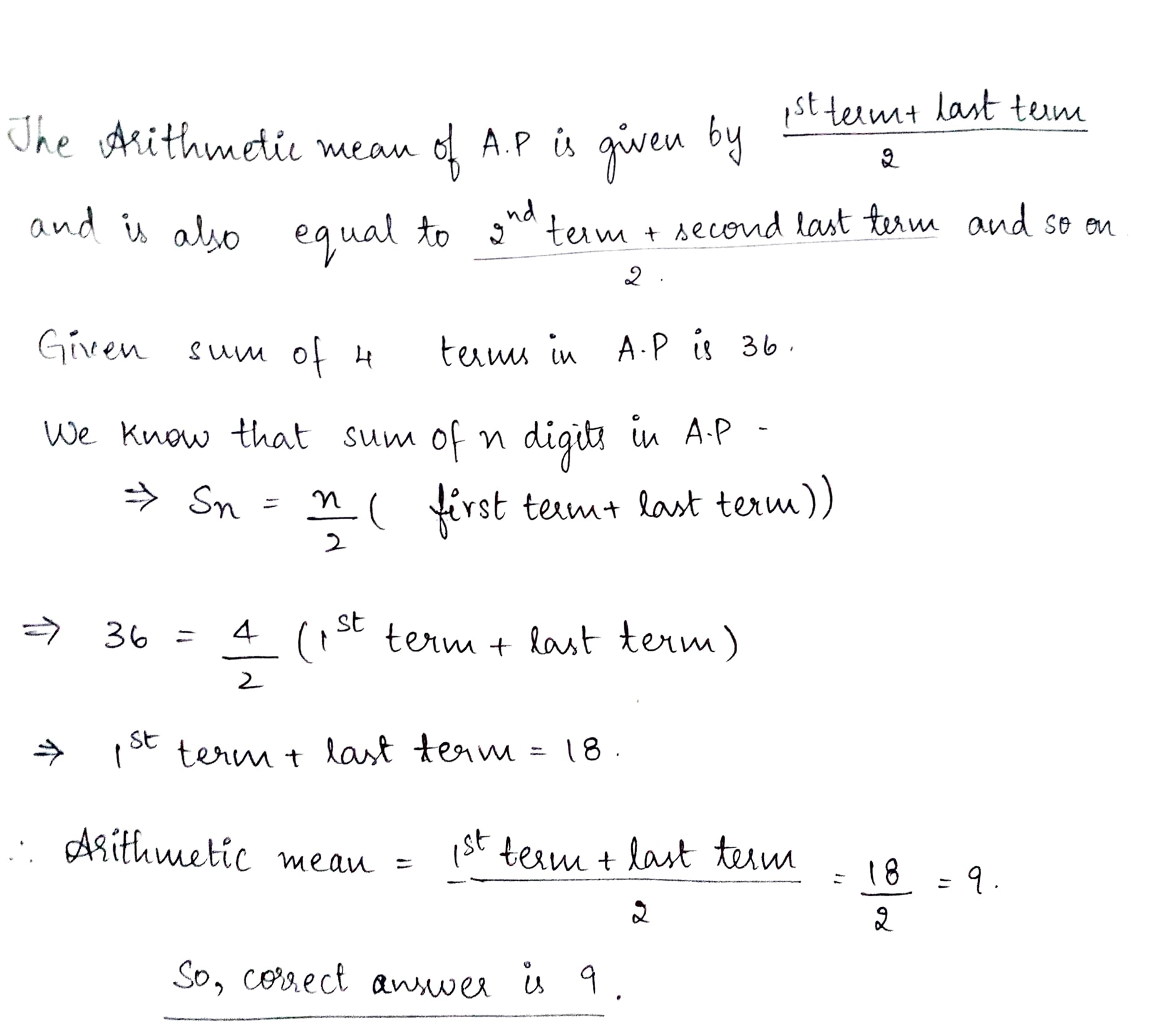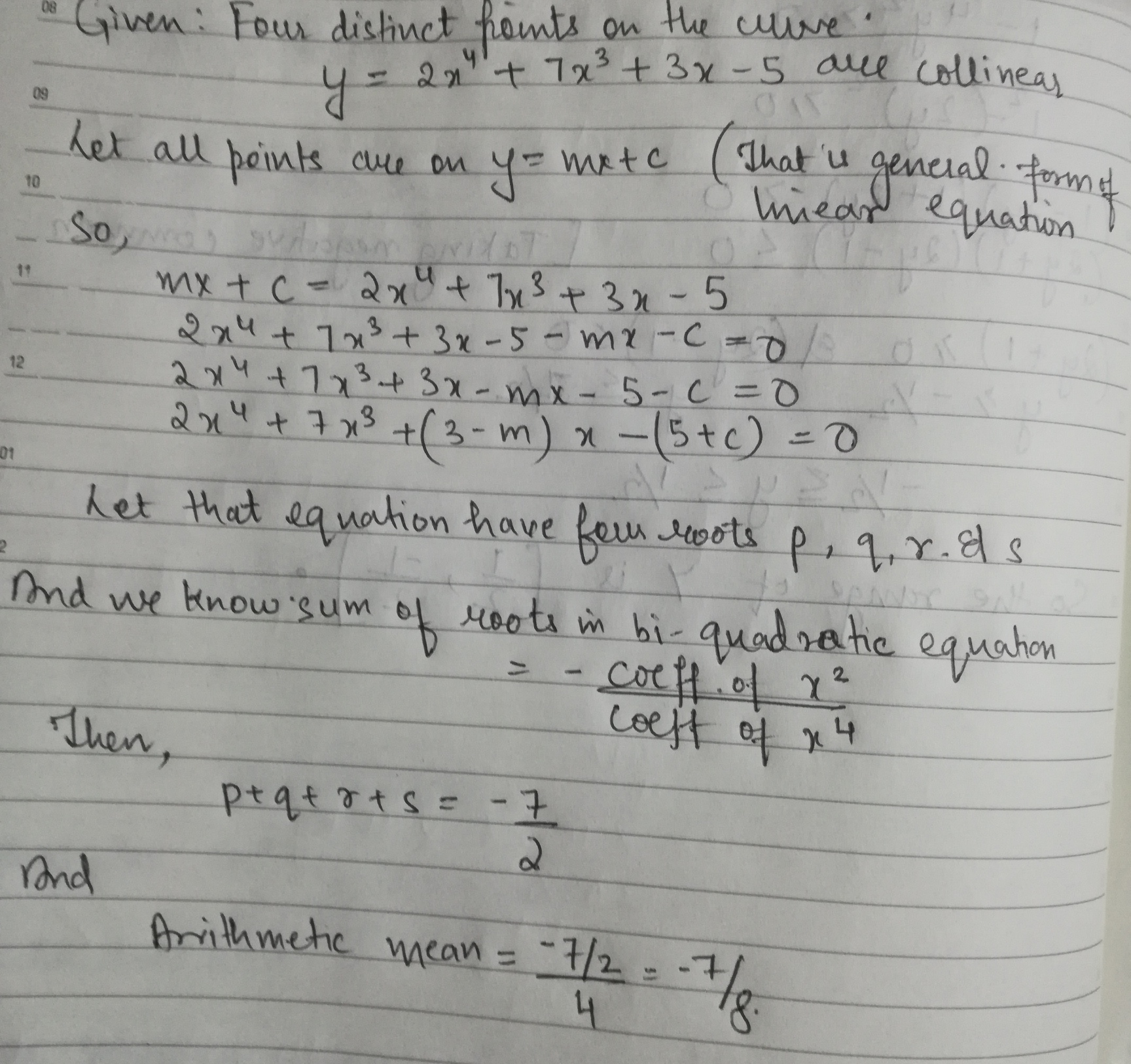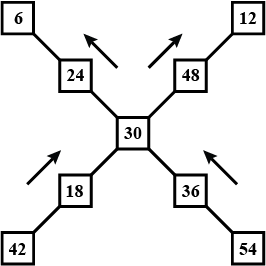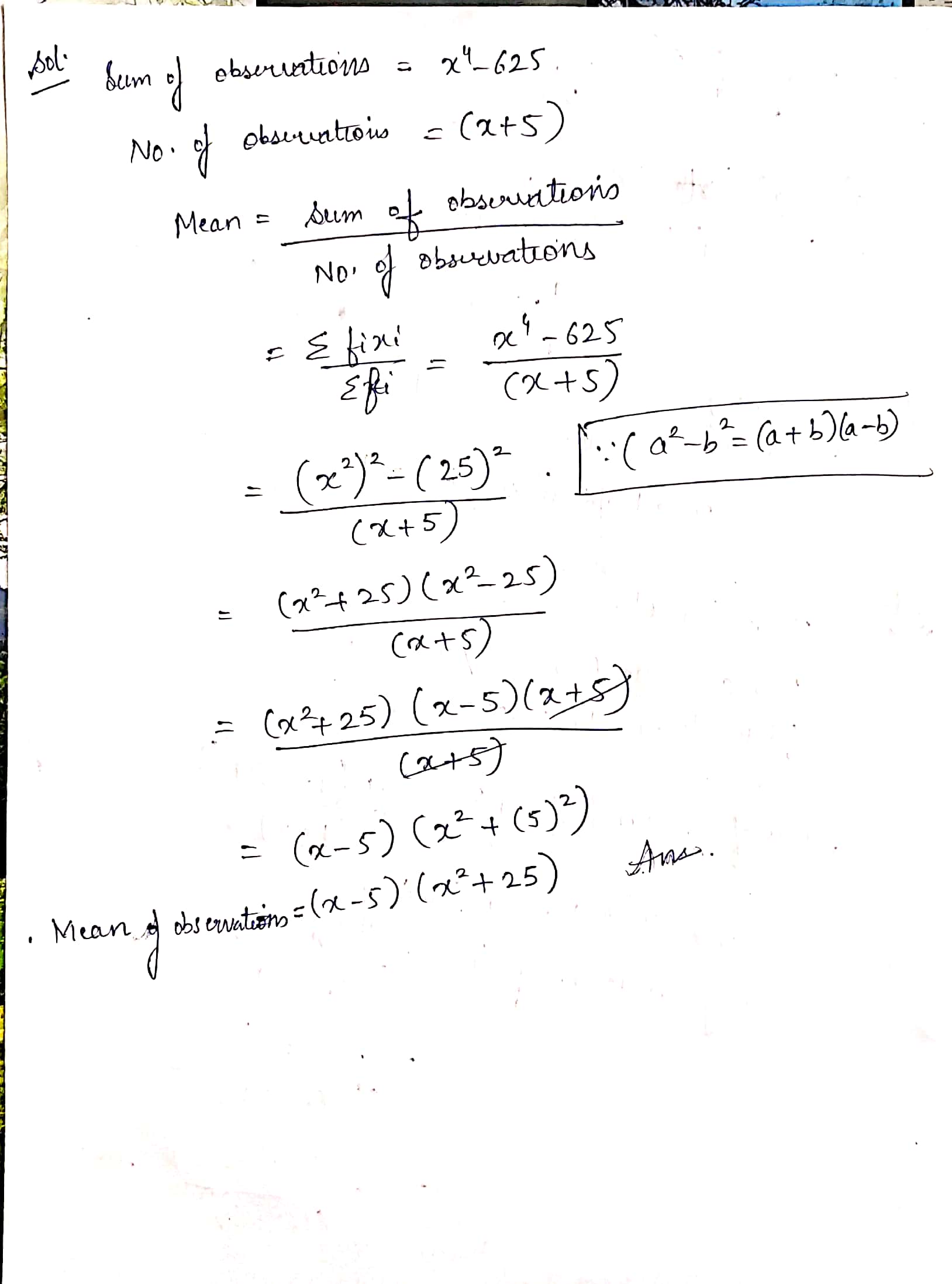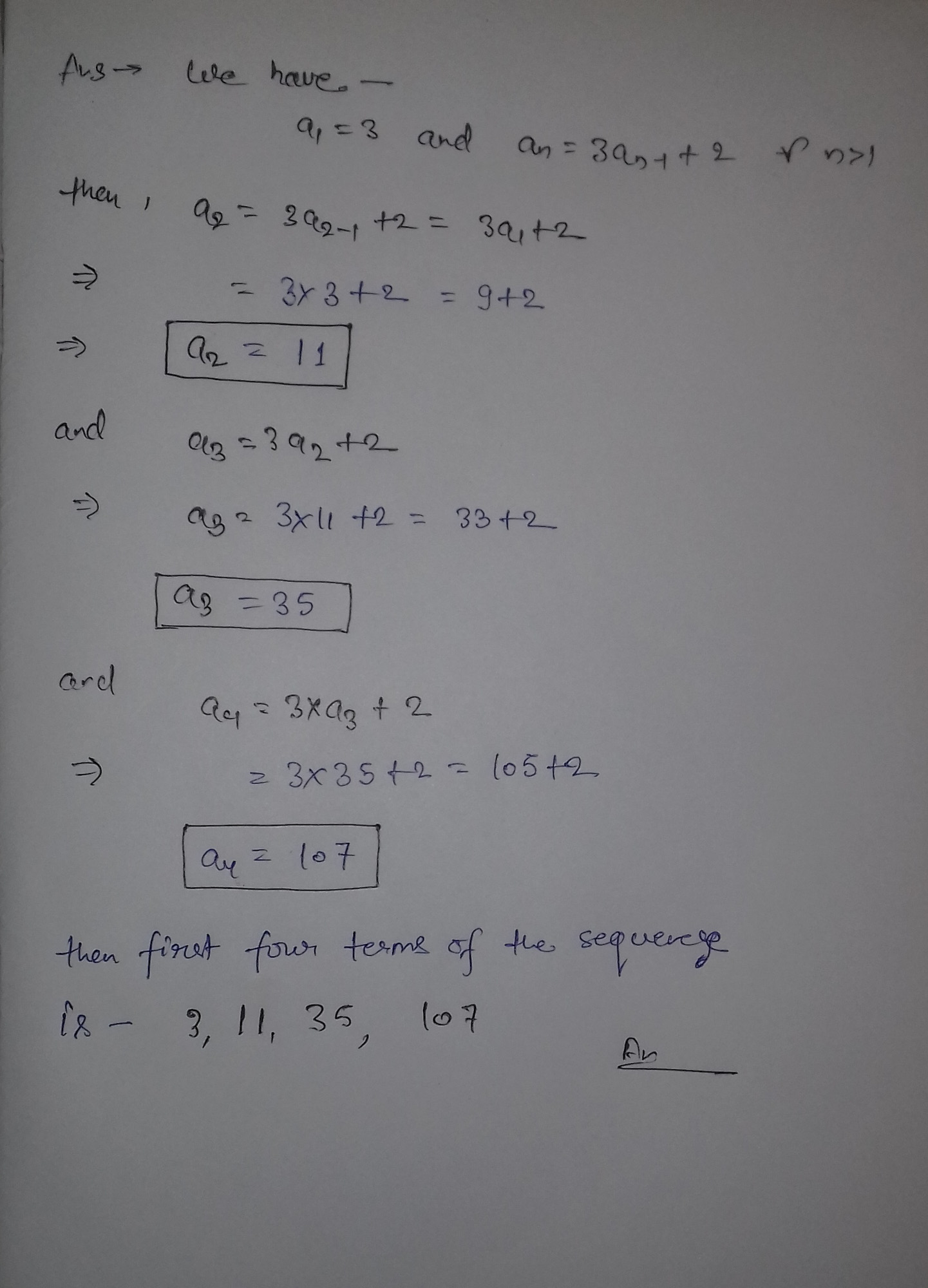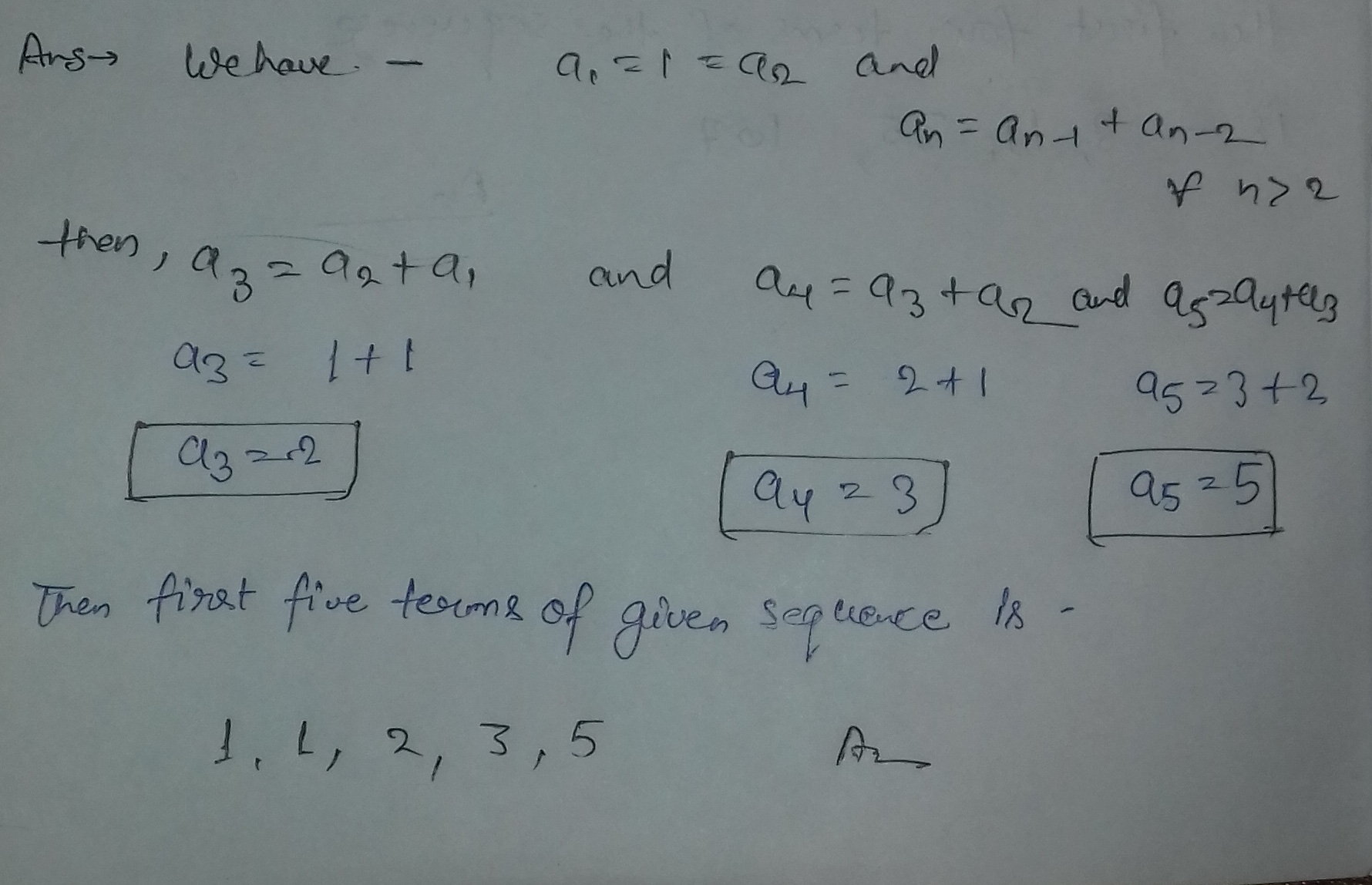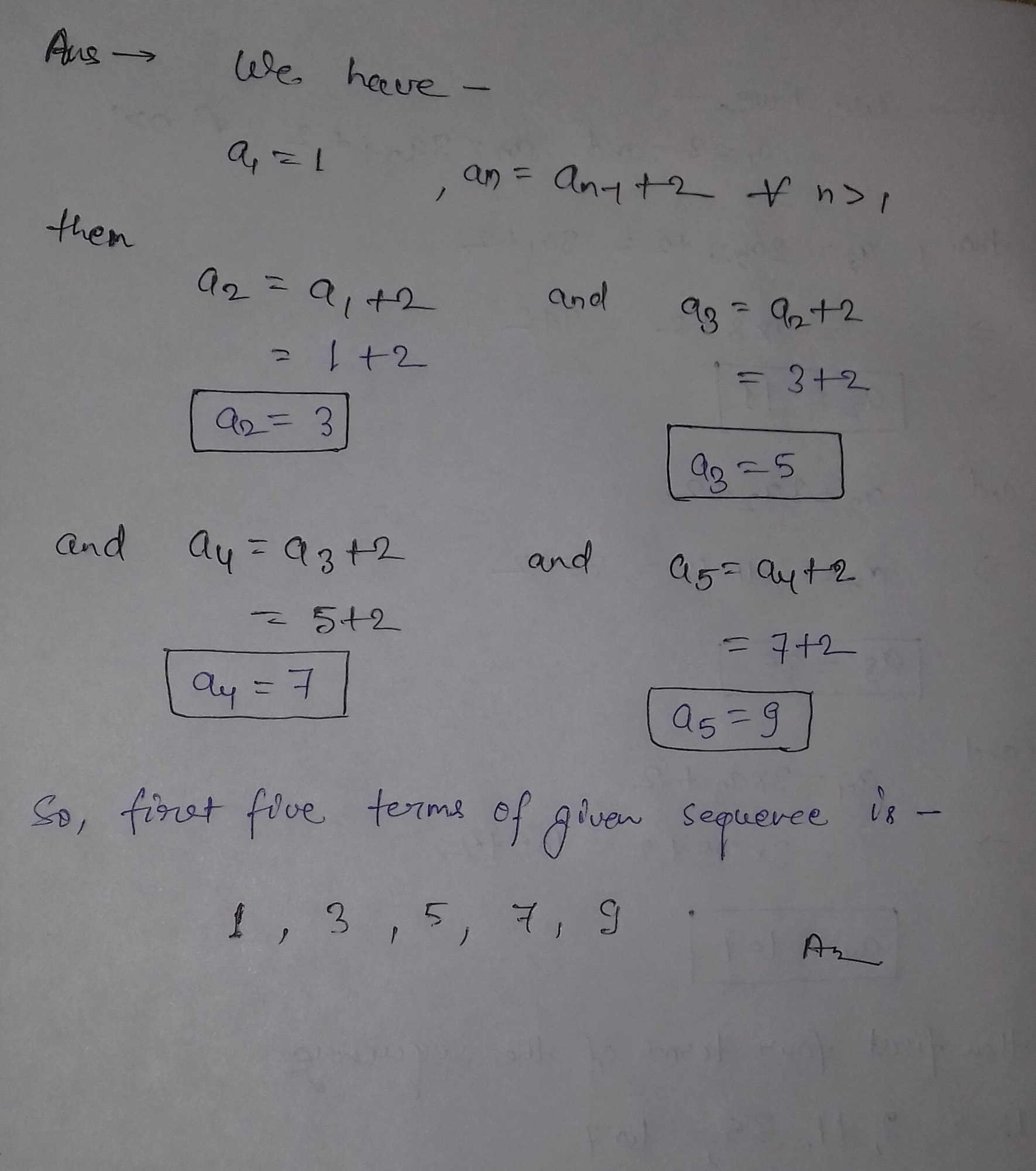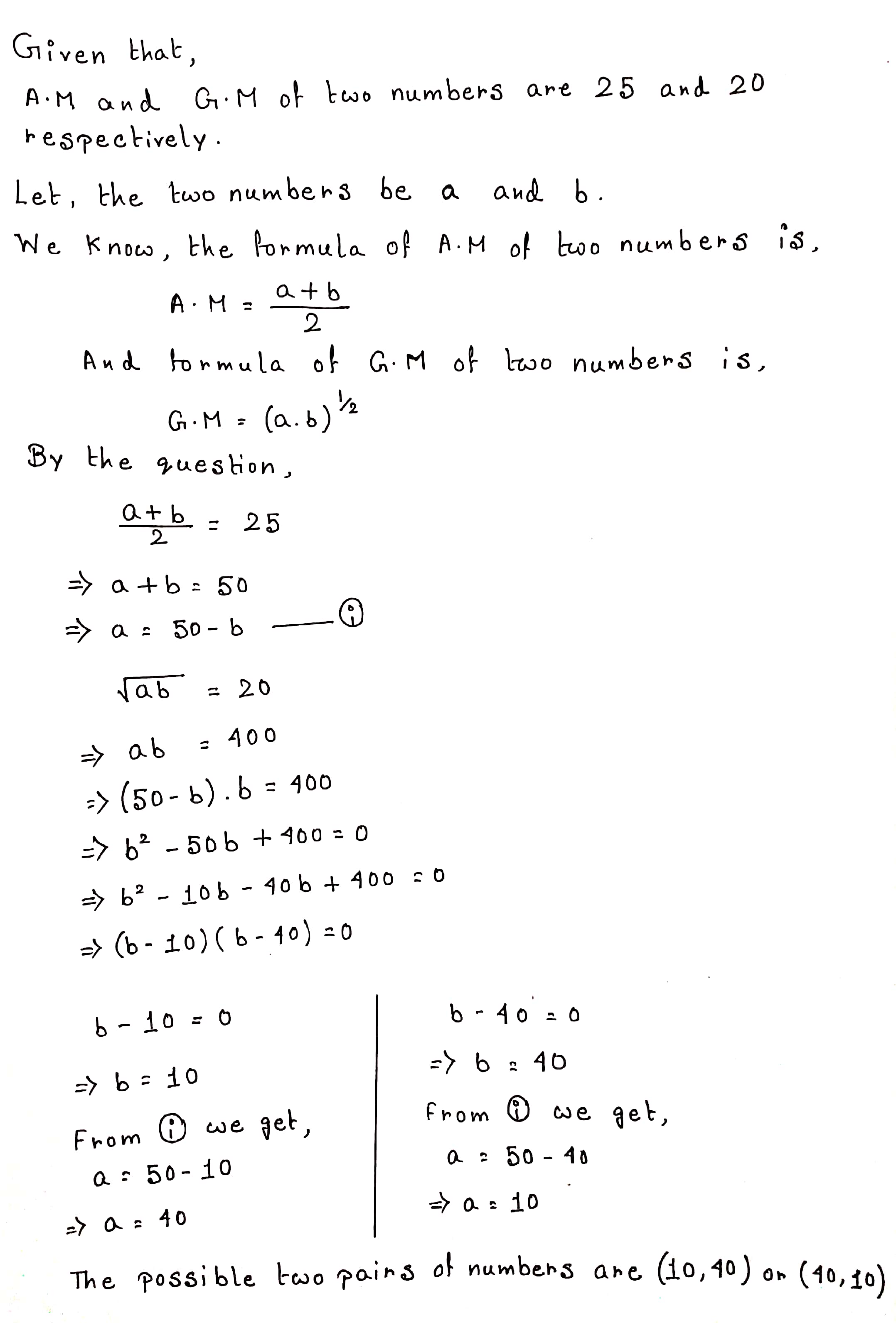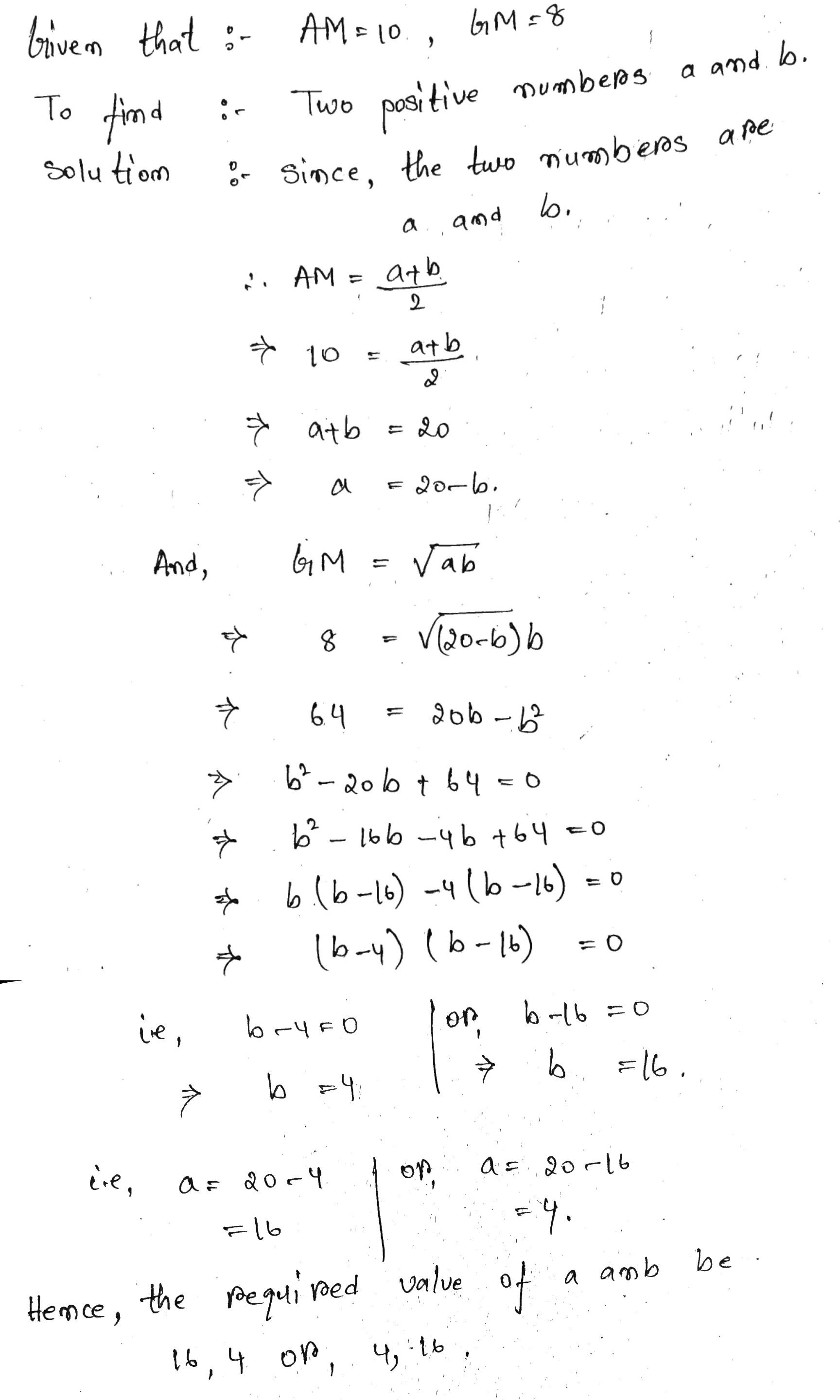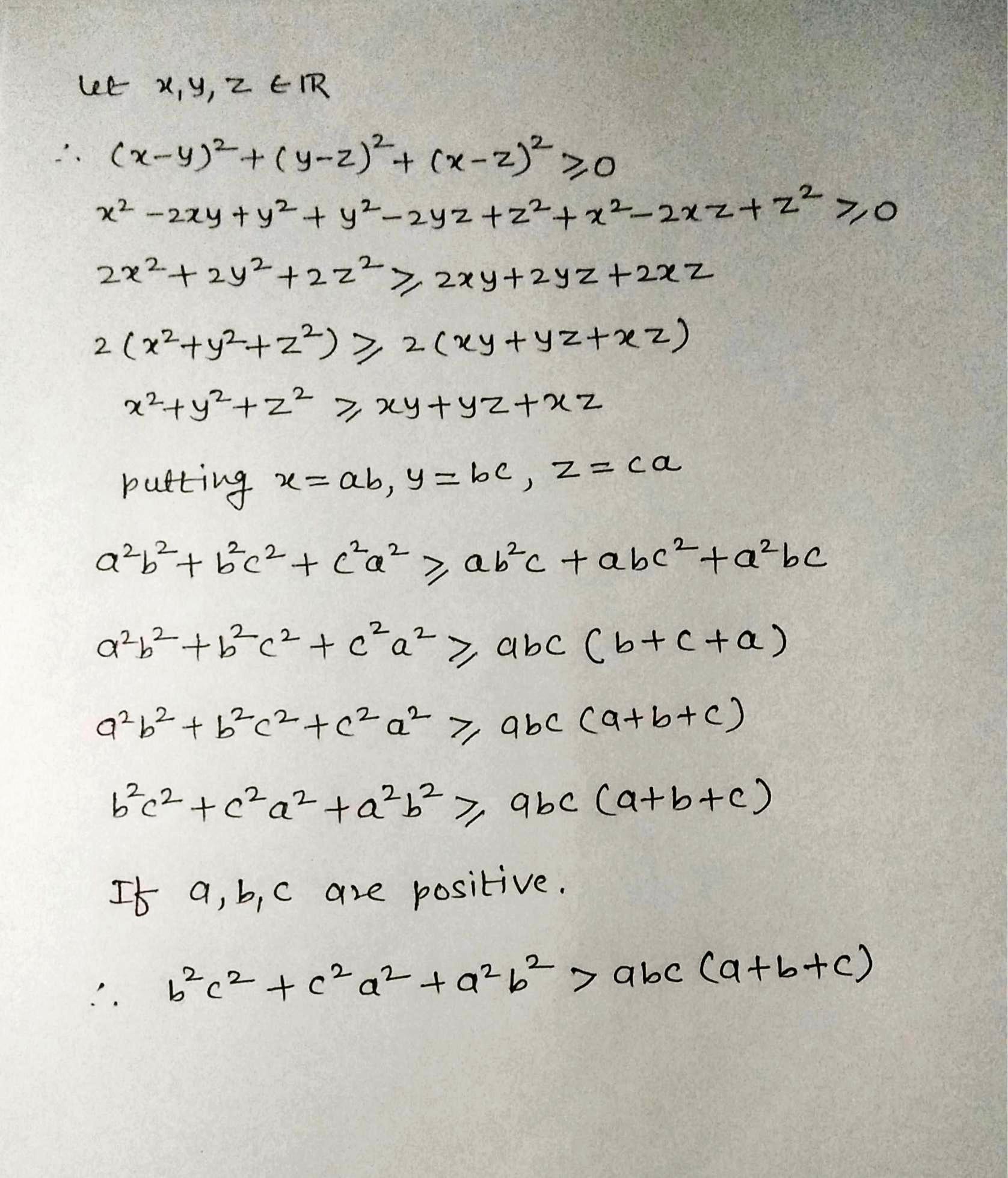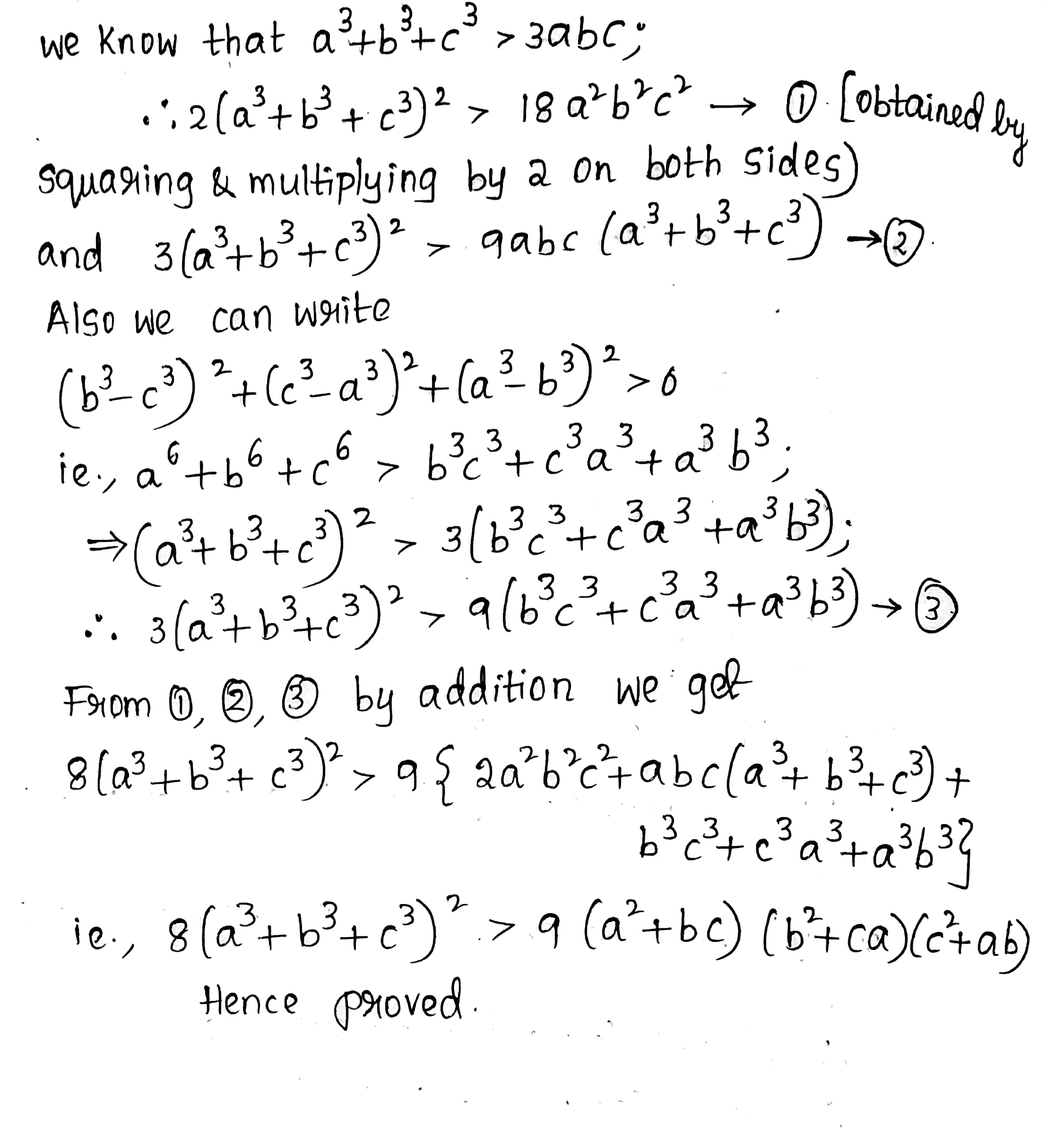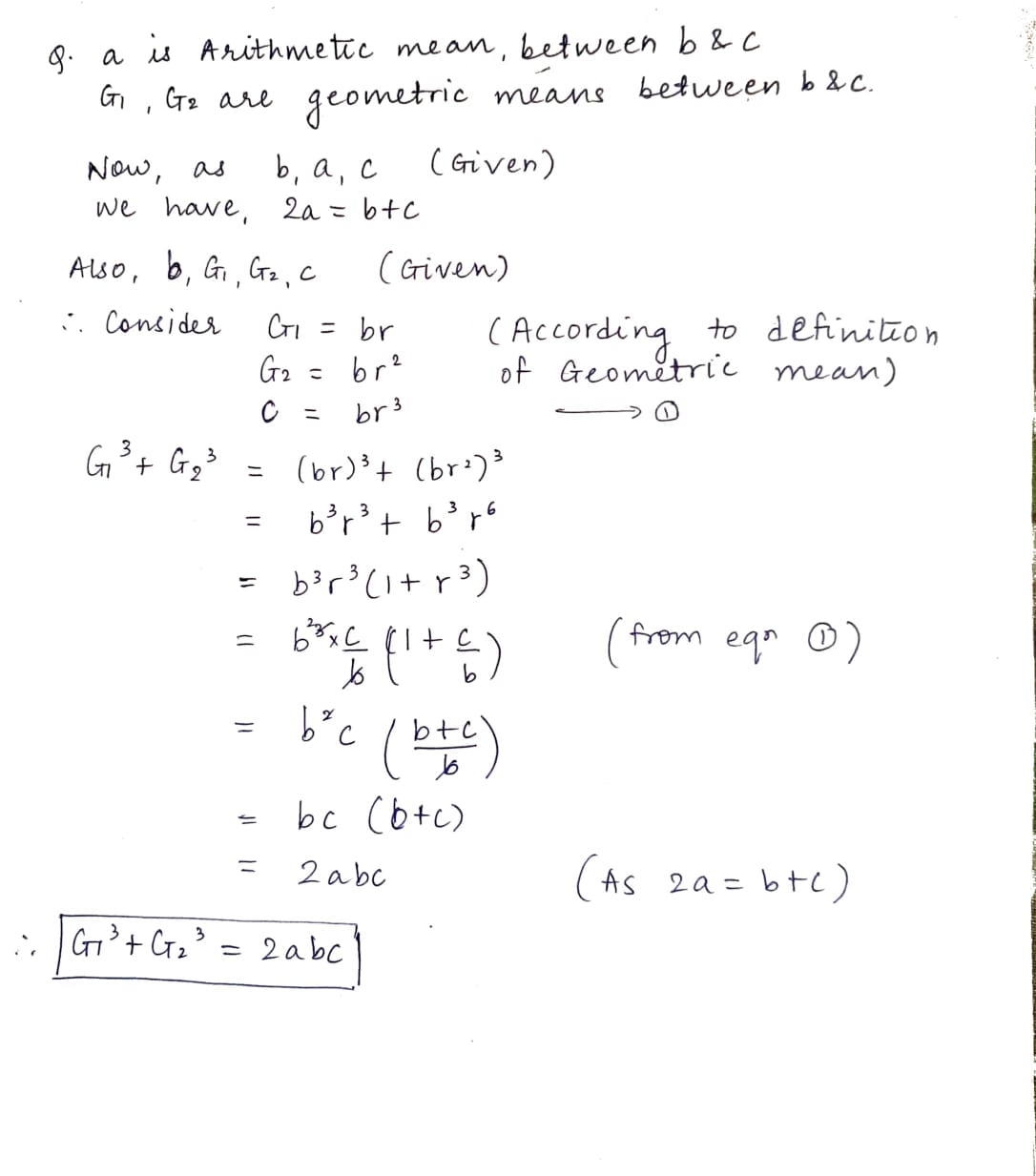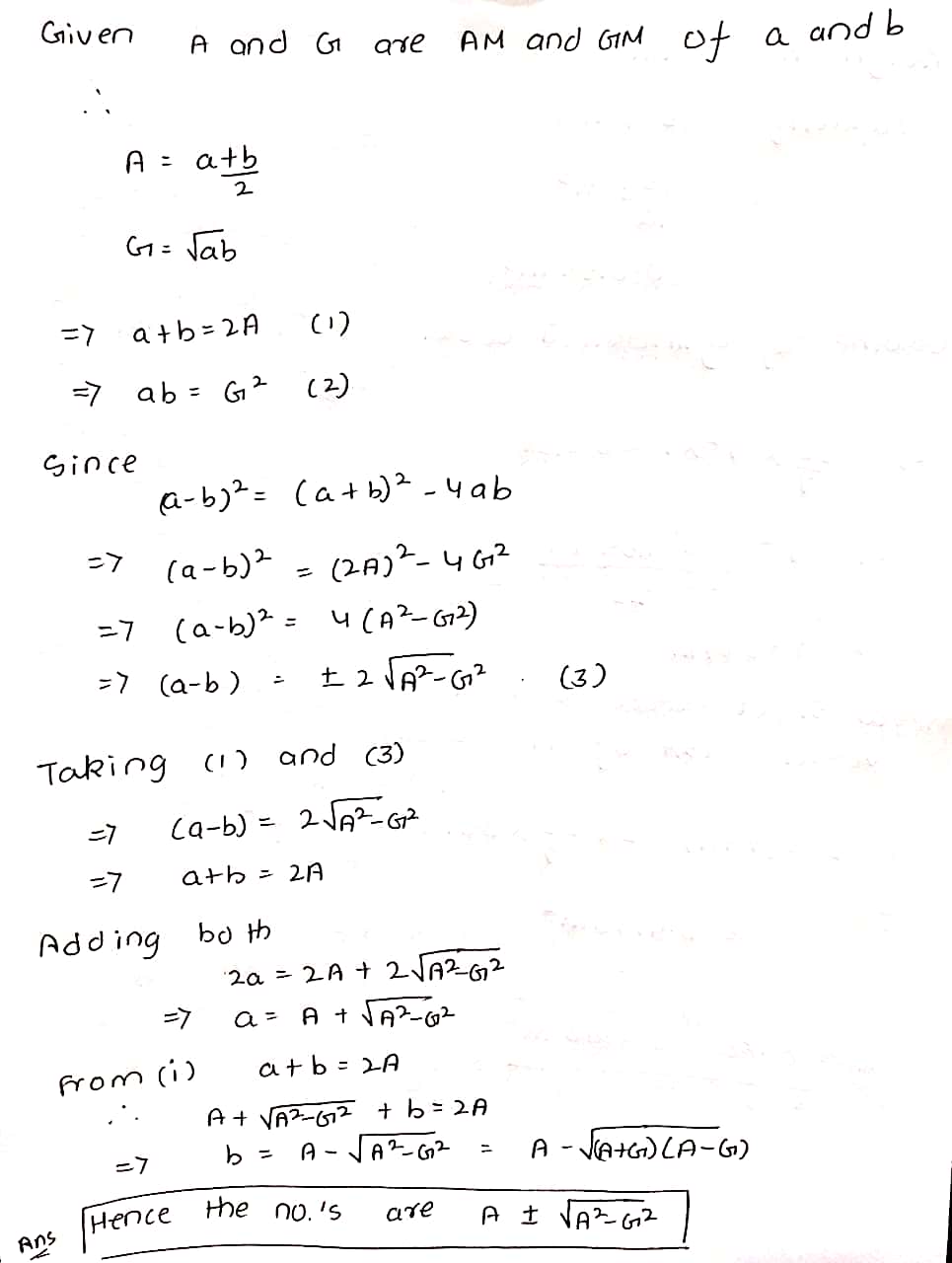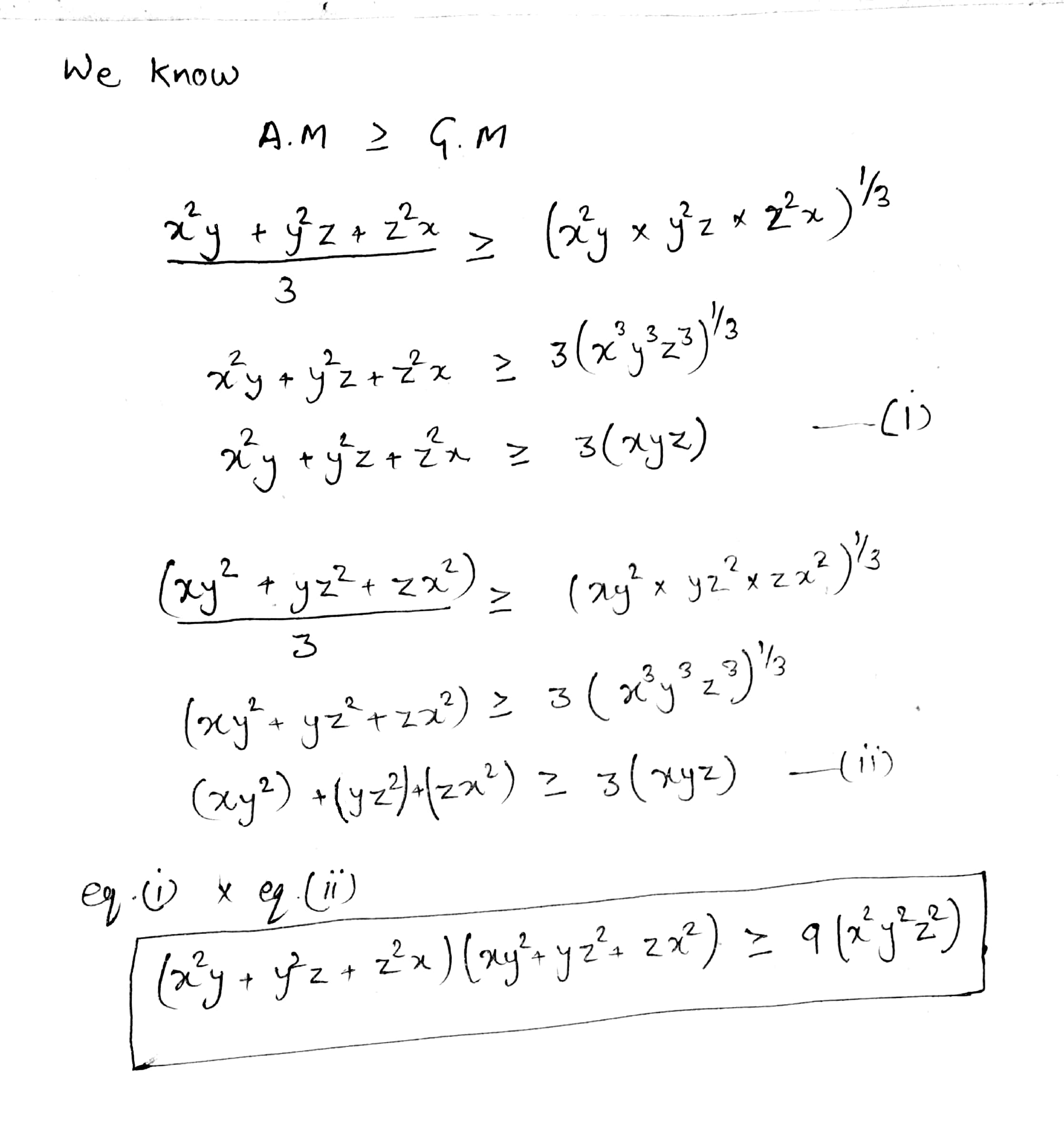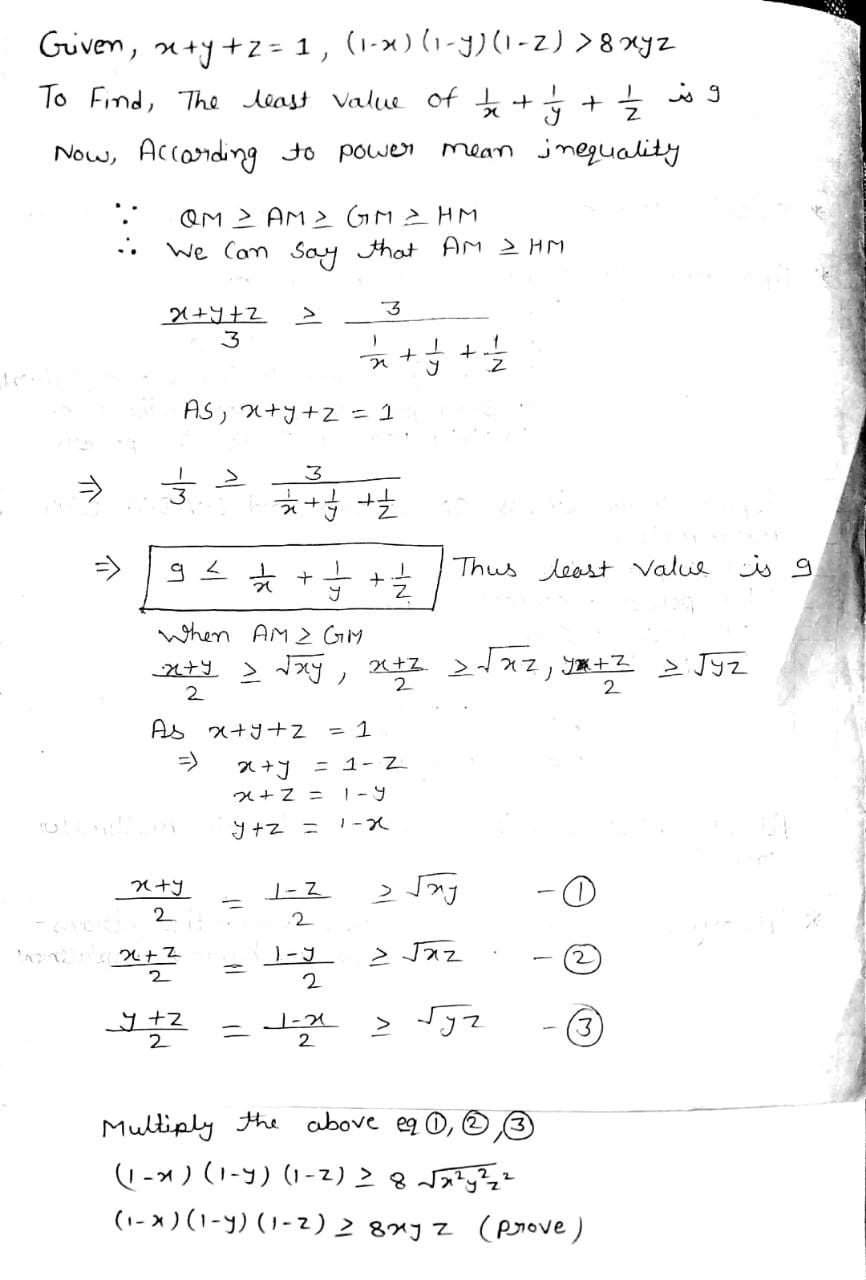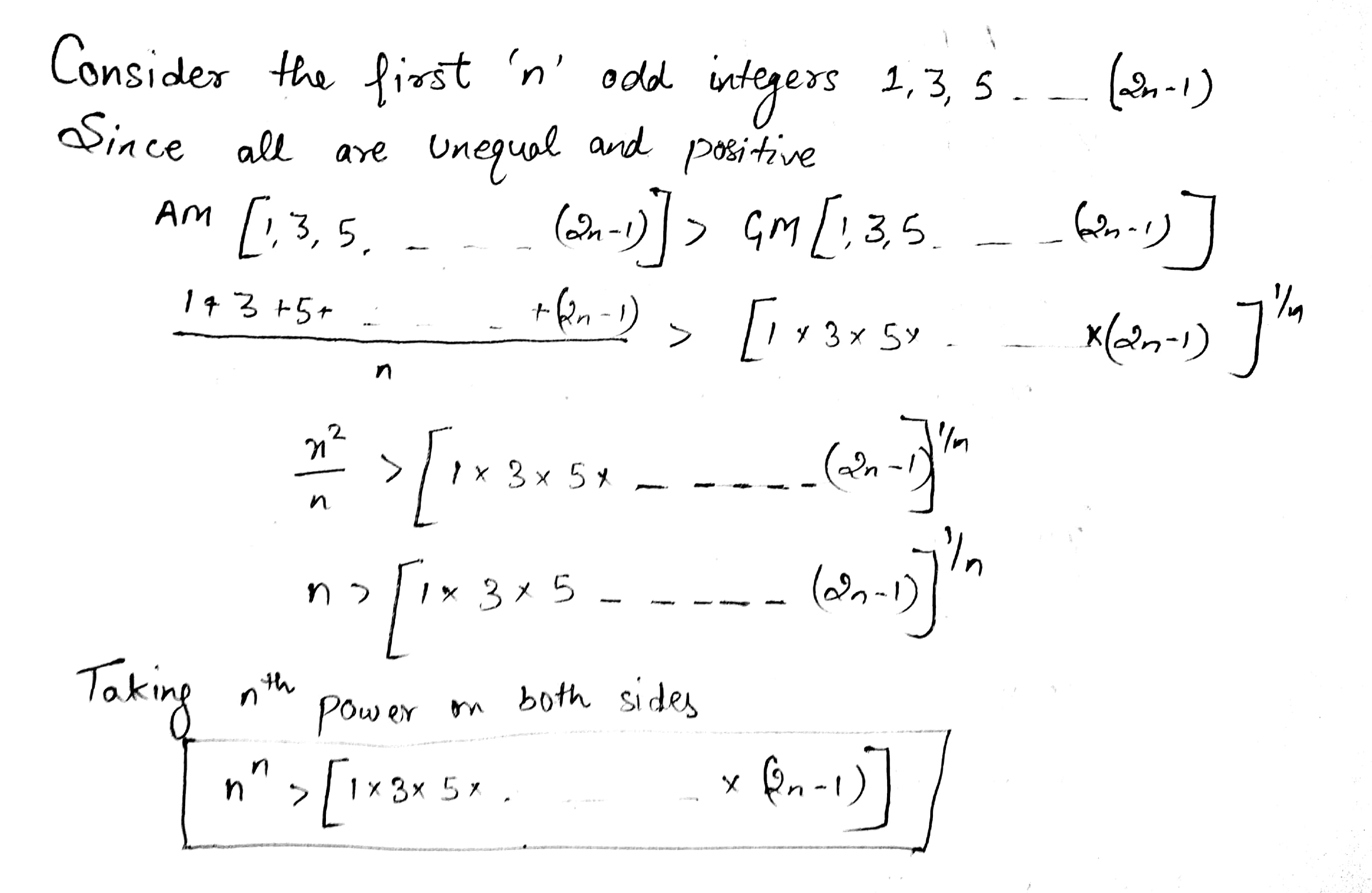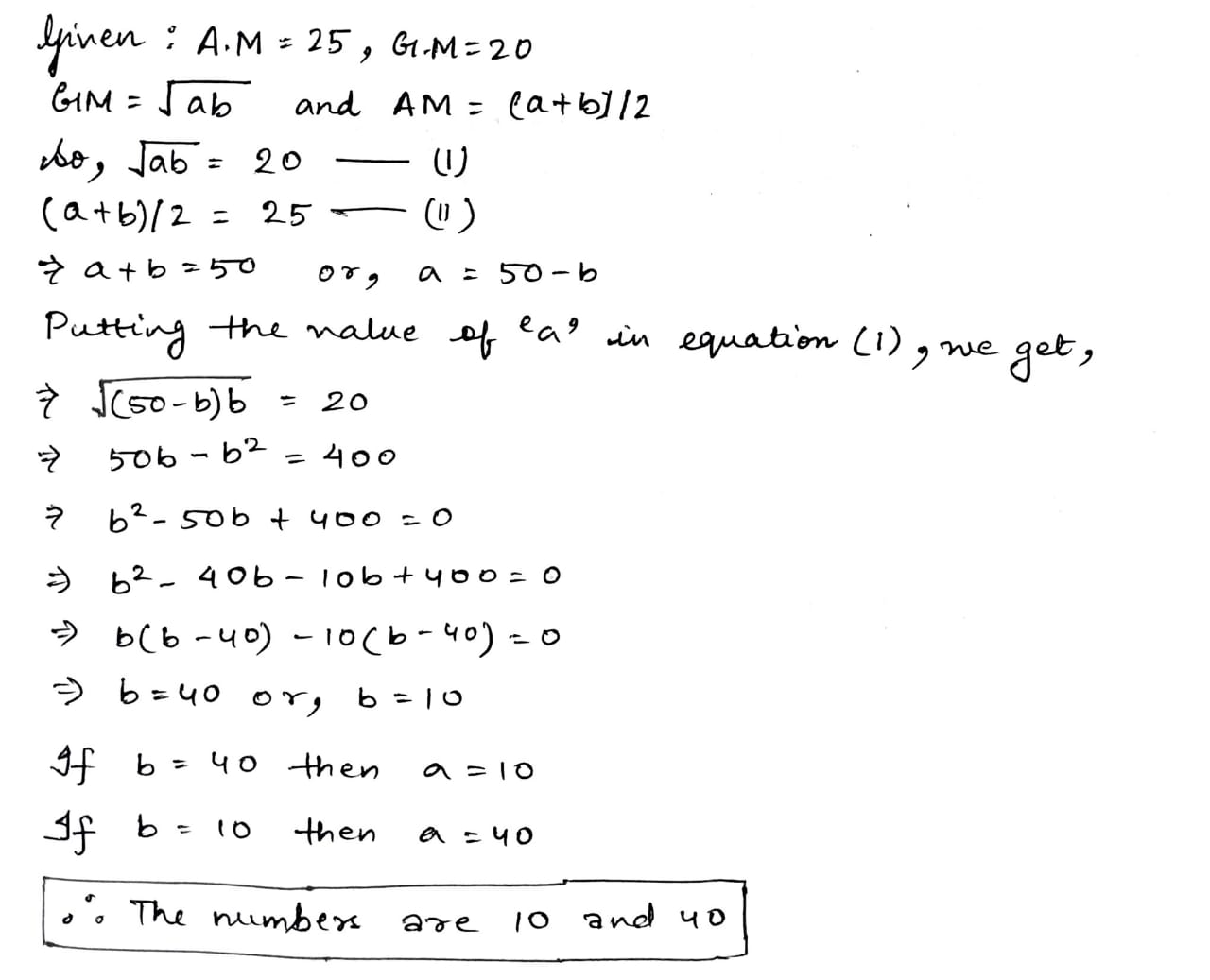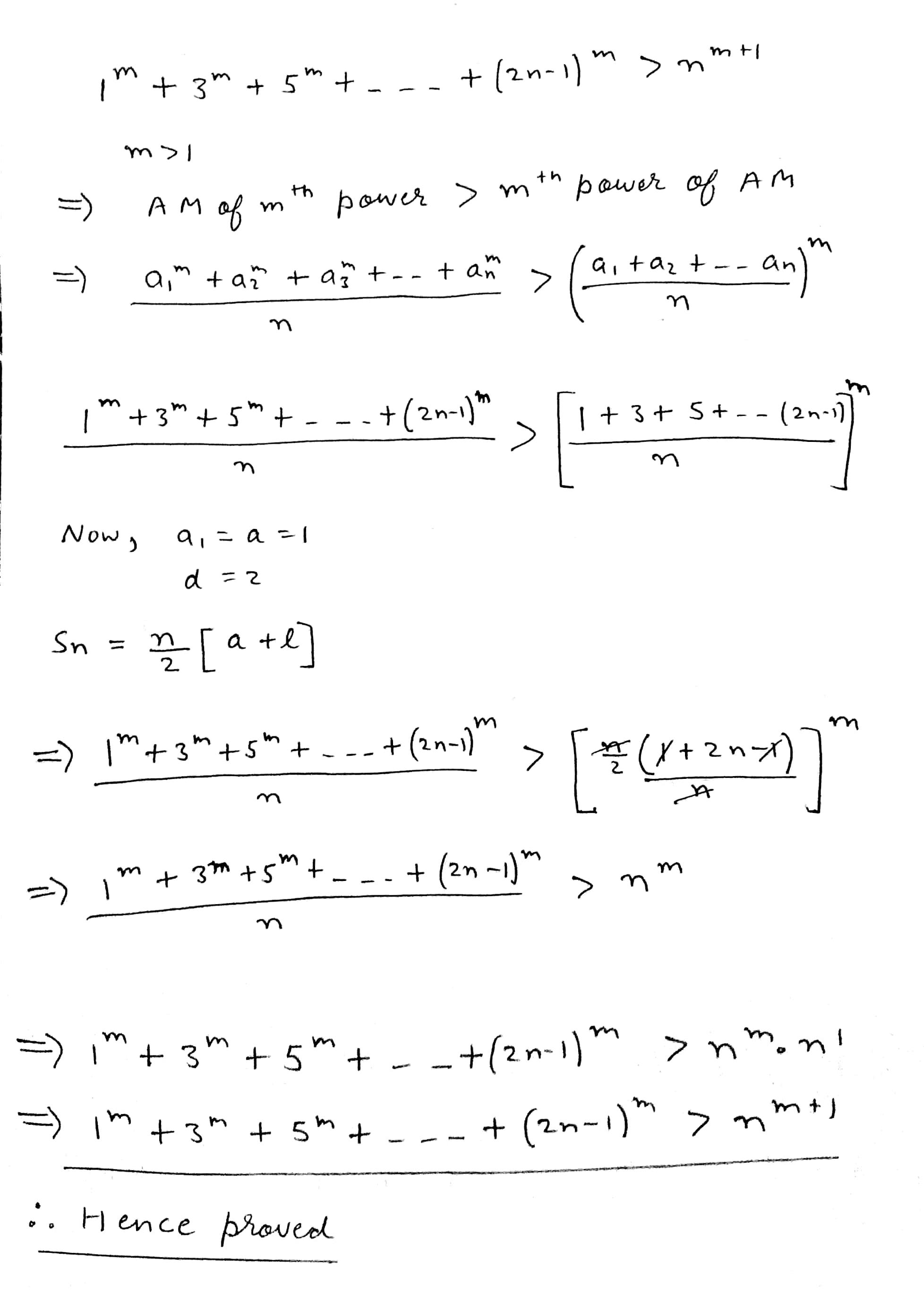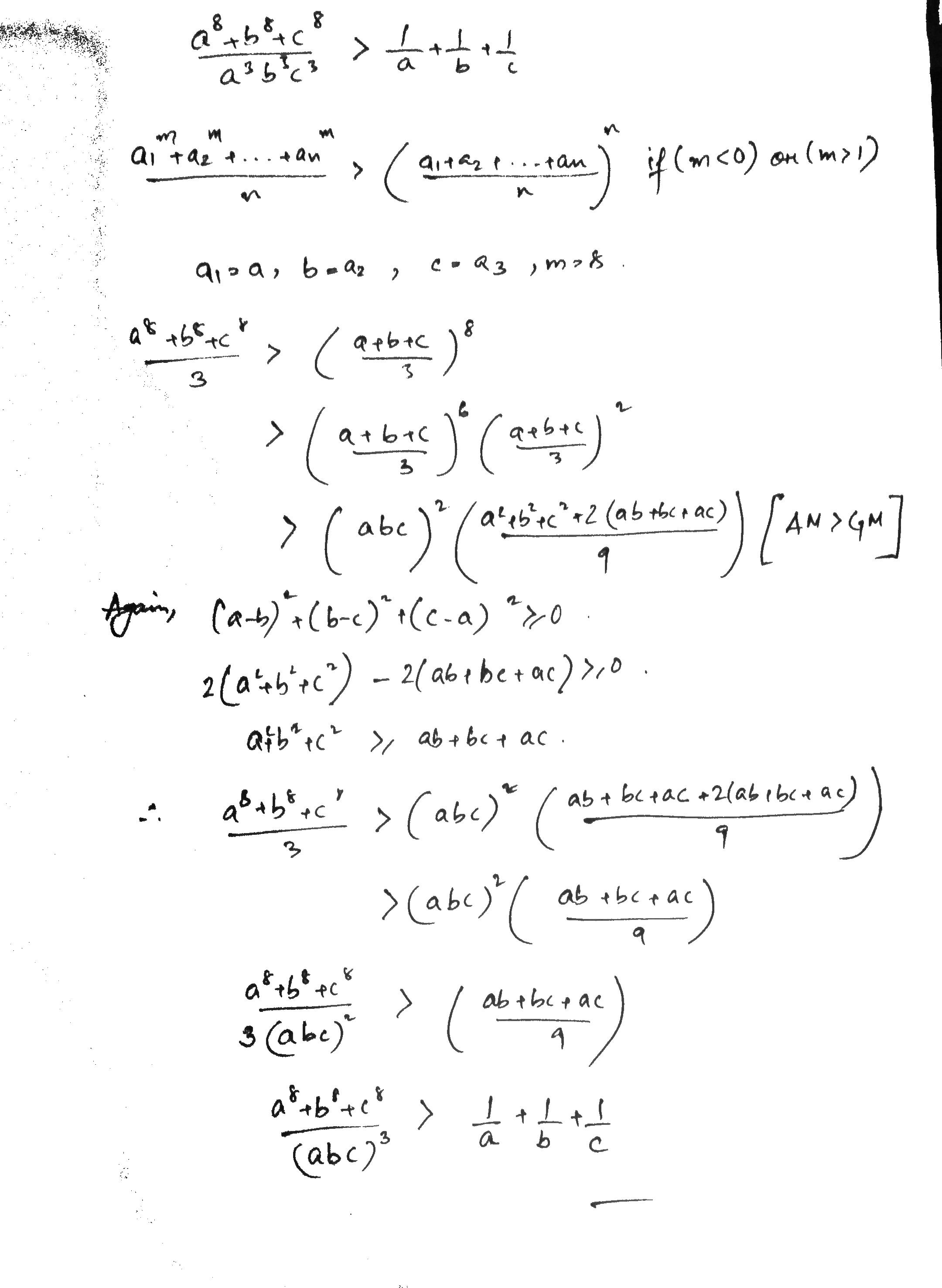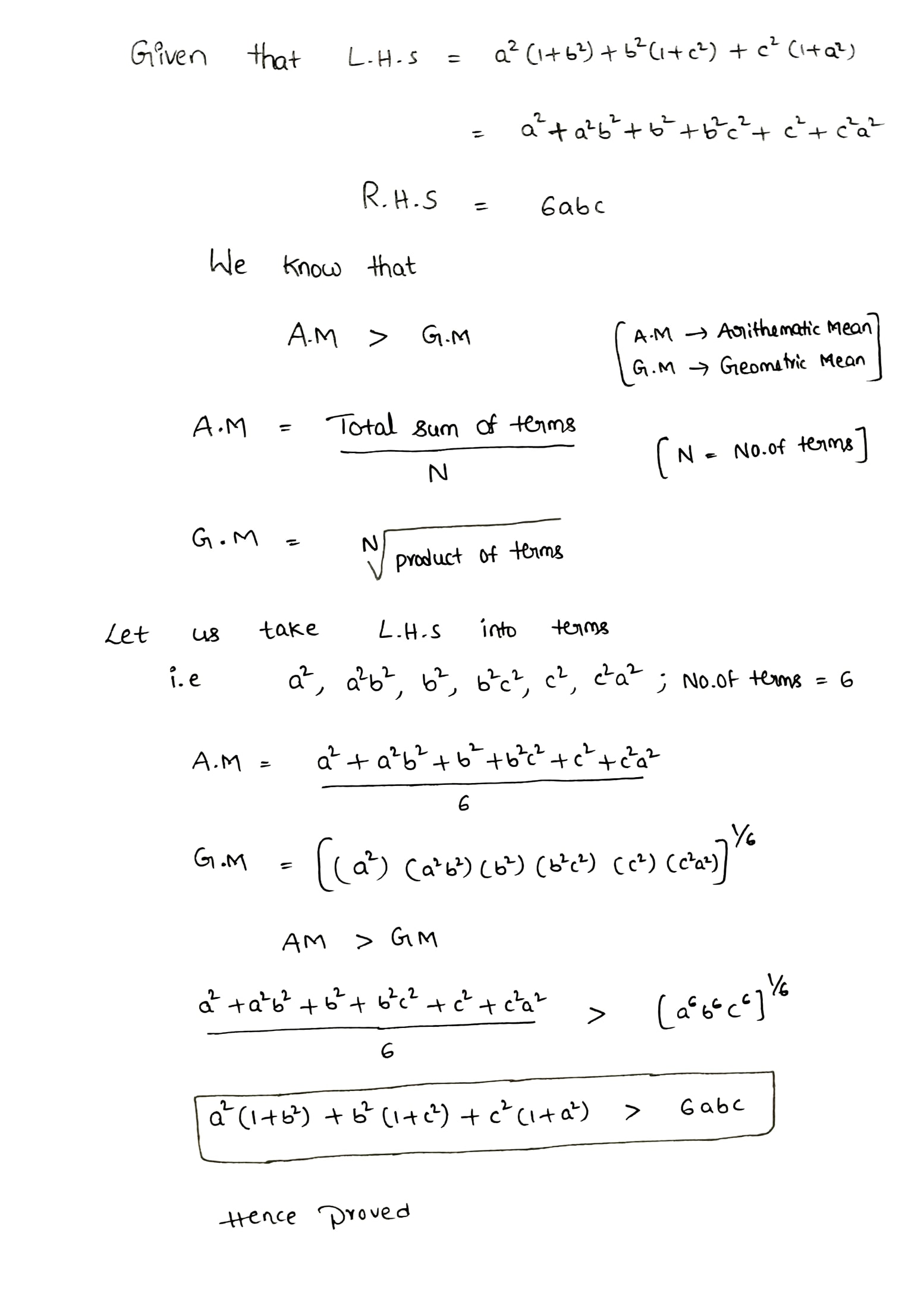Sequences And Series - Class 11 Commerce Applied Mathematics - Extra Questions
If an=n23n+2, find a5a1.
Find the value of n so that an+1+bn+1an+bn may be the geometric mean between a and b.
Write the first two terms of the sequence whose nth term is tn=3n−4
Find the first three terms of the sequence whose n th term is 2n+3.
Find the next two terms in the sequence:
1,2,4,7,11,.....
Find the next two terms in the sequence: 2,4,8,16,.....
Find the first three terms of the following sequence, whose nth term is
tn=4n−3
Find the first term of the sequence, where tn=2n+1.
If x is the geometric mean of (x+2) and (x−1), then find the value of x.
Find the first two terms of the following sequence:
tn=n+2
Find the first two terms of the sequence whose nth term is
tn=n+2.
Find the next two terms of the following sequence: 1,3,5,7,.....
If tn=2n+3, then find the first two terms of a given sequence
If nth term of a sequence is tn=n+1, then find the first two terms of the given sequence
If tn=4n, find t1.
Which of the following sequences are geometric sequences
(i) 5,10,15,20,....
(ii) 0.15,0.015,0.0015,.....
(iii) √7,√21,3√7,3√21,.....
Find the sum of the following series.
(i) 1+2+3+....+45
(ii) 162+172+182+....+252
(iii) 2+4+6+....+100
(iv) 7+14+21+....+490
(v) 52+72+92+392
(vi) 163+173+.....+353
The sum of the first three terms of a G.P. is 13 and sum of their squares is 91. Determine the G.P.
Find the common ratio and the general term of the following geometric sequences.
25,625,18125,....
If Tn=2n2+5 then find T3
The number of people who visited games village during common wealth games in New Delhi for the first four days was recorded as 15,290,14,181,14,235 and 10,578. Find the total number of people visited in these four days?
Study the pattern:
1×8+1=9
12×8+2=98
123×8+3=987
1234×8+4=9876
12345×8+5=98765
Write the next four steps. Can you find out how the pattern works ?
The arithmetic mean of the following data is 25, find the value of k.
| xi: | 5 | 15 | 25 | 35 | 45 |
| fi: | 3 | k | 3 | 6 | 2 |
Write the first five terms of each of the following sequences whose nth terms are:an=3n+2
Write the first five terms of each of the following sequences whose nth terms are:an=(−1)n.2n
Write the first five terms of each of the following sequences whose nth terms are:an=n2−n+1
Write the first five terms of each of the following sequences whose nth terms are:an=n−23
Write the first five terms of each of the following sequences whose nth terms are: an=n(n−2)2
Write the first five terms of each of the following sequences whose nth terms are:an=2n2−3n+1
Write the first five terms of each of the following sequences whose nth terms are:an=2n−36
Write the first five terms of each of the following sequences whose nth terms are: an=3n−25
Write the first five terms of each of the following sequences whose nth terms are:an=3n
The next term of the sequence 3,5,7,11,13,17,.. will be equal to:
State whether the given list of numbers is a sequence or not: 12,23,34,... If yes, find out the next number in the list.
26500 were divided equally among a number of people. If the number of people is increased by 15, the number of money reduces by 30 for each person. find the number of people as well as money each person got.
State whether the given list of numbers is a sequence or not : −52,53,−54,... If yes, find out the next number in the list.
Choose the odd one out:
33,−79,42,−89,−11,35
Find the G.M of 6 and 24
The third term of the sequence whose nth term is 1n2+1 is k.Find 9k
If a,b,c are three consecutive terms of A.P,Then b=____
Find the average of first twelve natural numbers.
Write down the sequence if nth term is:
a) 2nn
b) 3+(−1)n3n
b) 3+(−1)n3n
The G.M. between 1 and 25 is ___.
Solve: 3200=4500−n20.
Write the next term: √12,√27√48,√75,…......
If tn=2n, find t3.
Pointing to a man in a photograph, a woman said, "His brother's father is the only son of my grandfather". How is the woman related to the man in the photograph ?
If Mohan says that his mother is the only daughter of Shyam's mother, how is Shyam related to Mohan ?
Pointing to a photograph, a man said, " I have no brother or sister but that man's father is my father's son". Whose photograph was it ?
If an=n(n−3)n+4 then find the 18th term of this sequence.
What is sequence ?
Find the mean of 2 and 8
The mean of data 34,65,14,74,43 is
Some equations are solved on the basis of a certain system. On the same basis, find out the correct answer for the unsolved equation
4×6×9=649
7×3×2=372
8×9×4=?
If 23,k,5k8 are in A.P. then k=
If 1√a is the G.M. of 2 and 14, find a.
Find the geometric mean of the following pairs of numbers:
−8 and −2
If AM and GM of two positive numbers a and b are 10 and 8 respectively,find the numbers
Divided by 2.
Find the 7th term in the following sequence whose nth terms is an=n22n.
Multiplied by 3
Which term of the following sequences:
(a) 2,2√2,4…… is 128?
Find the 17th and 24th term in the following sequence whose nth term is an=4n−3.
Find the 9th term in the following sequence whose nth terms is an=(−1)n−1n3
Find the third term of the following sequence, whose nth term is given.tn=2n−5
If a1,a2,...an be an A.P. of +ive terms, then n∑k=1ak≥n√a21+(n−1)da1 where d is common difference of A.P. If you think this is true write 1 otherwise write 0 ?
If f(x)=logx1/9−log3x2(x>1), then max f(x) is equal to
(x−4) is geometric mean of (x−5) and (x−2) find x.
If ab=2a+3b where a > 0, b > 0, then find the minimum value of ab.
If the roots of the equation x3−ax2+4x−8=0 are real and positive, then the minimum value of a is
Y B T G O ?
If x,y,z,u>0 , then find the minimum value of x6+y6+2z3+2u3xyzu
Write down the sequence whose nth term is
(i) 2nn (ii) 3+(−1)n3n. How many terms of the sequences are are less than zero?
If tn=1+(−2)nn−1, then find t6−t5.
The sum of two numbers is 6 times their geometric mean show that numbers are in the ratio \displaystyle (3+2\sqrt { 2 } ):(3-2\sqrt { 2 } )
If \displaystyle \frac { { a }^{ n }+{ b }^{ n } }{ { a }^{ n-1 }+{ b }^{ n-1 } } is the A.M. between a and b, then find the value of n.
Each layer of the structure below is a square. The base is made up of 100 cubes, the second layer 81 cubes and the third layer 64 cubes. If the top layer of the structure consists of 16 cubes, how many layers does the structure have in all?
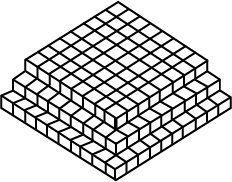
If the sum of 4 terms of an A.P. is 36, find the A.M. of these terms.
Find x, if the given numbers are in A.P. (a + b)^2 , x , (a - b)^2
Find the next two terms in the sequence:
1,3,7,15,31,.......
Find x, if \sqrt 2, x, \dfrac{1}{\sqrt 2} are in G.P.
Find GM between 4 and 36.
If xy=6, then minimum value of 2x+3y is __________.
If S_{1}, S_{2} and S_{3} are the sum of first n, 2n and 3n terms of a geometric series respectively, then prove that S_{1}(S_{3} - S_{2}) = (S_{2} - S_{1})^{2}
Shew that the highest power of n which is contained in {n^{r} - 1} is equal to \dfrac {n^{r} - nr + r - 1}{n - 1}.
Sum of two numbers is 6 times their geometric mean, show that numbers are in the ratio \left( 3+2\sqrt { 2 } \right) :\left( 3-2\sqrt { 2 } \right) .
The sum of the three number is 68. If the ratio of the first to second is 3 : 2 and that of the second to the third is 5 : 3, then the second number is
Which is smaller? 2 or \log _{ \pi }{ 2 } +\log _{ 2}{ \pi }
Find out if the given list of numbers 3,8,15,24,... is a sequence or not. If so, then find the 5^{th} term of the sequence.
The next term of the sequence 1,5,25,125,.. will be equal to:
If \sin { \theta } is G.M of \sin { \phi } and \cos { \phi } , then prove that \cos { 2\theta } =2\cos ^{ 2 }{ \left( \cfrac { \pi }{ 4 } +\phi \right) }
In an A.P. If m (a_m) = n (a_n). Find (a_{m+n} ) ^{th} term
If G is the geometric mean of x and y, then
t\frac{1}{{{G^2} - {x^2}}} + \frac{1}{{{G^2} - {y^2}}} = \frac{1}{{{G^2}}}
Find the value of n so that \dfrac{a^{n+1}+b^{n+1}}{a^{n}+b^{n}} may be the geometric mean between a and b.
1-0,1-0,...1-0
If the distinct points on the curve y = 2{x^4} + 7{x^3} + 3x - 5 are collinear, then find the arithmatic mean of x-coordinates of the aforesaid points
Find number of digits 1025^{th} terms of the sequence 1,2,2,4,4,4,4,8,8,8,8,8,8,8,8,........ ?
In ALFA + BETA + GAMA = DELTA, each letter stands for a unique number. Find the value of each letter.
There are two sections A and B of a class consisting of 36 and 44 students respectively. If the average weight of section A is 40 kg and that of section B is 35 kg, find the average weight of the whole class?
Find the next term of AP \sqrt{2},\sqrt{8},\sqrt{18}
Find two numbers whose arithmetic mean is 34 and the geometric mean is 16.
Solve - 234:579 ::125:?
Solve the equation for x:
1+4+7+10+.....+x=287
If \dfrac { 1 }{ x+y } ,\dfrac { 1 }{ 2y } ,\dfrac { 1 }{ y+z } are the three consecutive terms of an A.P. prove that x, y, z are the consecutive terms of a G.P.
The monthly salaries in rupees of 30 workers in a factory are given below:
5000,\ 7000,\ 3000,\ 4000,\ 4000,\ 3000,\ 3000,\ 3000,\ 8000,\ 4000,\\ 4000,\ 9000,\ 3000,\ 5000,\ 4000,\ 4000,\ 3000,\ 5000,\ 5000,\ 6000,\\ 8000,\ 3000,\ 3000,\ 6000,\ 7000,\ 7000,\ 6000,\ 6000,\ 4000,\ 8000.
Find the mean of monthly salary.
Find the sum of the products of the corresponding terms of the sequence 16,32 and 128,32,8,2,\dfrac {1}{2}
Introducing a woman, a man said, "Her husband is only son of my mother".How is the woman related to that man ?
Which term of the sequence 24,\,23\dfrac{1}{4},\,22\dfrac{1}{2},\,21\dfrac{3}{4},... is the first negative term?
Find the mean of the following.
All the factors of 48.
If the mean of x,x+2,x+4,x+8 is 20 find x.
If the sides of a triangle are in Geometric Progression and the largest angle is twice the smallest angle then find the relation for r.
Place first nine multiples of 6 in the blanks in such a manner that each row adds up to 150.
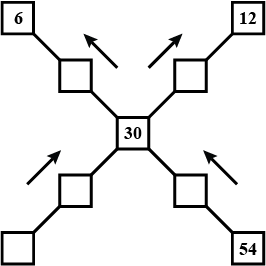
There are 10 compartments in passenger train carries on average 15 passengers per compartment. If atleast 15 passengers were sitting in each compartment, no any compartment has equal no of passengers , and any compartment does not exceed the number of average passengers except {10}^{th} compartment.Find how many passengers can be accommodated in {10}^{th} compartment ?
Check whether the following sequence is A.P. If it is A.P., Find the common difference.0.3, 0.33, 0.333...
Write the first five terms of the following sequence.
a_1=a_2=2, a_n=a_{n-1}-1, n > 2.
The sum of (x+5) observations is (x^{4}-625). Find the mean of the observations.
Find the first four terms of the sequence defined by a_1=3 and a_n=3a_{n-1}+2, for all n > 1.
Write the first five terms of the following.
a_1=1=a_2, a_n=a_{n-1}+a_{n-2}, n > 2.
Write the first five terms of the following sequence.
a_1=1, a_n=a_{n-1}+2, n > 1.
Which term of the sequence 12+8i, 11+6i, 10+4i,... is purely real?
Find the geometric mean of the following pairs of numbers :
2 and 8 .
Find AM of 5 and 23.
Which term of the sequence 12+8i, 11+6i, 10+4i,.... is purely imaginary?
Find AM of 2 and 16.
Find the two numbers whose A.M. is 25 and GM is 20.
Find two positive numbers a and b, whose AM=10 and GM=8.
Find the GM between the numbers 5 and 125.
Find the GM between the numbers 1 and \dfrac{9}{16}.
If a, b, c are in AP; x is the GM between a and b; y is the GM between b and c; then show that b^2 is the AM between x^2 and y^2.
Find the GM between the numbers -8 and -2.
The AM between two positive numbers a and b(a > b) is twice their GM. Prove that a:b=(2+\sqrt{3}):(2-\sqrt{3}).
Find the GM between the numbers a^3b and ab^3.
Find the GM between the numbers -6.3 and -2.8.
Find the GM between the numbers 0.15 and 0.0015.
Write the quadratic equation, the arithmetic and geometric means of whose roots are A and G respectively.
Find general term of series \log_e(1+3x+2x^2)=3x-\dfrac{5x^2}{2}+\dfrac{9x^3}{3}-\dfrac{17x^4}{4}+..
\log_e(1+3x+2x^2)=3x-\dfrac{5x^2}{2}+\dfrac{9x^3}{3}-\dfrac{17x^4}{4}+..
If a,b,c are three distinct positive real numbers in G.P., then prove that { c }^{ 2 }+2ab>3ac
Find the general term of the series\log_e(1+3x)=3x-\dfrac{(3x)^2}{2}+\dfrac{(3x)^3}{3}-\dfrac{(3x)^4}{4}+....
In how many parts an integer N\ge 5 should be dissected so that the product of the parts is maximized.
Calculate the greatest and least values of the function
f(x)=\cfrac { { x }^{ 4 } }{ { x }^{ 8 }+2{ x }^{ 6 }-4{ x }^{ 4 }+8{ x }^{ 2 }+16 }
Prove that { _{ }^{ n }{ C } }_{ 1 }{ \left( { _{ }^{ n }{ C } }_{ 2 } \right) }^{ 2 }{ \left( { _{ }^{ n }{ C } }_{ 3 } \right) }^{ 3 }....{ \left( { _{ }^{ n }{ C } }_{ n } \right) }^{ n }\le { \left( \cfrac { { 2 }^{ n } }{ n+1 } \right) }^{ { _{ }^{ n+1 }{ C } }_{ 2 } },\forall n\in N\quad
Show that (x + y + z)^3 > 27xyz.
Show that b^2c^2 + c^2a^2 + a^2b^2 > abc (a + b + c).
Show that minimum value of \dfrac{(x+a)(x+b) }{(x+c)}, where a>c, b>c is (\sqrt{a-c}+\sqrt{b-c})^{2} for real values of x>-c .
If x,y,z are positive real numbers and x=\cfrac { 12-yz }{ y+z } . The maximum value of (xyz) equals
If a,b,c are positive real numbers. Then prove that { \left( a+1 \right) }^{ 7 }{ \left( b+1 \right) }^{ 7 }{ \left( c+1 \right) }^{ 7 }>{ \left( 7 \right) }^{ 7 }{ a }^{ 4 }{ b }^{ 4 }{ c }^{ 4 }
If x,y\in { R }^{ + } satisfying x+y=3, then the maximum value of {x}^{2}y is
If a_n = \frac{3}{4} - \big(\frac{3}{4}\big)^2 + \big(\frac{3}{4}\big)^3 + ... + (-1)^{n - 1} \big(\frac{3}{4}\big)^n and b_n = 1 - a_n , then find the least natural number n_0 such that b_n > a_n \forall n \geq n_0.
If a,b and c are positive and 9a+3b+c=90 then the maximum value of \left( \log { a } +\log { b } +\log { c } \right) is (Base of the logarithm is 10)
For any x,y\in R,xy>0 then the minimum value of \cfrac { 2x }{ { y }^{ 3 } } +\cfrac { { x }^{ 3 }y }{ 3 } +\cfrac { 4{ y }^{ 2 } }{ 9{ x }^{ 4 } } is
Prove that 8(a^{3}+b^{3}+c^{3})^{2}>9(a^{2}+bc)(b^{2}+ca)(c^{2}+ab)
The minimum value of the sum of real numbers { a }^{ -5 }+{ a }^{ -4 }+3{ a }^{ -3 },1,{a}^{8} and {a}^{10} with a> 0 is
Find the geometric progression whose 4th term is 54 and 7th term is 1458.
Let x be the arithmetic mean and y, z be the two geometric means between any two positive numbers. Then \dfrac{y^3 + z^3}{xyz} = __________.
Find the first negative term of sequence 999,995,991,987,
...
Multiplied by 2
The mean of 100 observation isIt is found that an observation 53 was misread asFind the correct mean.
Divided by 0.5
the value of \displaystyle \sum^{10}_{i = 1}(x_i - \bar{x})
Decreased by 20%
Increased by 60%
Decreased by 7
prove that2\sin^{-1} \left ( \dfrac{3}{5} \right ) = \tan^{-1} \left ( \dfrac{24}{7} \right )
Find the value of the following :
\cos^{-1} \left ( \dfrac{4}{5} \right ) + \cos^{-1} \left ( \dfrac{12}{13} \right )
Find the value of the following :
\sin^{-1} \left ( \dfrac{8}{17} \right ) + \sin^{-1} \left ( \dfrac{3}{5} \right )
Find the mean of 75 numbers, if the mean of 45 of them is 18 and the mean of the remaining ones is 13.
Increased by 25%
Decreased by 40%
Multiplied by 3 and then divided by 2.
The mean of 18, 24, 15, 2x + 1 and 12 isFind the value of x.
Find the value of the following :
\tan^{-1} \left [ \tan\left ( \pi + \dfrac{\pi }{6} \right ) \right ]
Find the value of the following :
\cos^{-1} \left ( \cos\left ( \dfrac{13\pi }{6} \right ) \right )
Which term of the sequence
\dfrac{1}{3} , \dfrac{1}{9} , \dfrac{1}{27} ........... is \dfrac{1}{19683}?
Which term of the sequence
2 , 2 \sqrt{2} , 4 , .............. is 128 ?
Define sequence of numbers
prove \tan^{-1} \left ( \dfrac{63}{16} \right ) = \sin^{-1} \left ( \dfrac{5}{13} \right ) + \cos^{-1} \left ( \dfrac{3}{5} \right )
Find the value of the following :
$$\tan^{-1} \sqrt{x} = \dfrac{1}{2} \cos^{-1} {x}$$
Find the value of the following :
\cos^{-1} \left ( \dfrac{12}{13} \right ) + \sin^{-1} \left ( \dfrac{3}{5} \right )
Find derivative of:
y = \dfrac{\sin (ax + b)}{\cos (cx + d)}
Find the value of the following :
\left [ \tan^{-1} \dfrac{1}{5} + \tan^{-1} \left ( \dfrac{1}{7} \right )\right ] + \left [ \tan^{-1} \left ( \dfrac{1}{3} \right ) + \tan^{-1} \left ( \dfrac{1}{8} \right ) \right ]
If x, y, z are in G.P., arithmetic mean of x,y is A_1 and A.M. of y,z is A_2 then prove that:
(i) \dfrac{1}{A_1} + \dfrac{1}{A_2} = \dfrac{2}{y} (ii) \dfrac{x}{A_1} + \dfrac{z}{A_2} = 2
If G_1 and G_2 are two geometric mean between a and b, then prove that G_1 G_2= ab.
If AM and GM of roots of a quadratic equation are 8 and 5 respectively , then obtain the quadratic equation .
If a, b, c be positive and ab (a+b)+bc(b+c)+ca(c+a)\geq \lambda abc, then value of \lambda is
Prove that the product of n geometric mean between any two numbers is nth power of their G.M.
If a be one A.M and G_1 and G_2 be then geometric means between b and c then { G }_{ 1 }^{ 3 }+{ G }_{ 2 }^{ 3 }=?
Write the next term of each of the following sequences :
1, 5, 14, 30, 55,.....
If A and G be A.M. and G.M., respectively between two positive numbers, prove that the numbers are A\pm \sqrt {(A+G)(A-G)}
Show that (x^2y + y^2z + z^2x) (xy^2 + yz^2 + zx^2) \geq 9x^2y^2z^2.
If x + y + z = 1, show that the least value of \dfrac{1}{x} + \dfrac{1}{y} + \dfrac{1}{z} is 9; and that (1 - x) (1 - y) ( 1 - z) > 8 xyz.
Show that n^n > 1.3.5 .... (2n - 1).
Find two positive numbers a and b, whose AM=25 and GM=20.
If s be the sum of n positive unequal quantities a,b, c...., then
\dfrac{s}{s-a}+\dfrac{s}{s-b}+\dfrac{s}{s-c}+.... > \dfrac{n^2}{n-1}.
If a and b are positive and unequal, prove that
a^n-b^n > n(a-b)(ab)^{\dfrac{n-1}{2}}.
If m is negative or positive and greater than 1 show that
1^{m}+3^{m}+5^{m}+.......+(2n-1)^{m}>n^{m+1}
Given that x,y,z are positive reals such that xyz=32. If the minimum value of { x }^{ 2 }+4xy+4{ y }^{ 2 }+2{ z }^{ 2 } is equal m then the value of \dfrac{m}{16} is
If \dfrac{x}{a^2-y^2}=\dfrac{y}{a^2-x^2}=\dfrac{1}{b}, and xy=c^2, show that when a and c are unequal, (a^2-c^2)^2-b^2c^3=0, or a^2+c^2-b^2=0
If a, b, c are real positive quantities, show that
\dfrac{1}{a}+\dfrac{1}{b}+\dfrac{1}{c}< \dfrac{a^8+b^8+c^8}{a^3b^3c^3}.
Show that
a^{2}(1+b^{2})+b^{2}(1+c^{2})+c^{2}(1+a^{2})>6abc
The arithmetic mean between m and n and the geometric mean between a and b are each equal to \dfrac{ma+nb}{m+n}: find m and n in terms of a and b.
Show that, if a, b, c, d be four positive unequal quantities and s=a+b+c+d, then
(s-a)(s-b)(s-c)(s-d) > 81 abcd.
Class 11 Commerce Applied Mathematics Extra Questions
- Basics Of Financial Mathematics Extra Questions
- Circles Extra Questions
- Descriptive Statistics Extra Questions
- Differentiation Extra Questions
- Functions Extra Questions
- Limits And Continuity Extra Questions
- Logarithm And Antilogarithm Extra Questions
- Mathematical And Logical Reasoning Extra Questions
- Number Theory Extra Questions
- Numerical Applications Extra Questions
- Permutations And Combinations Extra Questions
- Probability Extra Questions
- Relations Extra Questions
- Sequences And Series Extra Questions
- Set Theory Extra Questions
- Straight Lines Extra Questions
- Tangents And Its Equations Extra Questions
